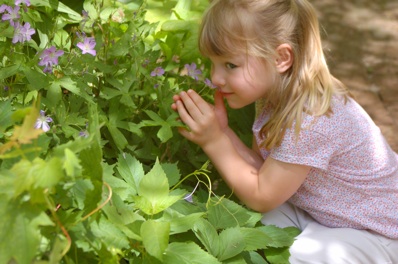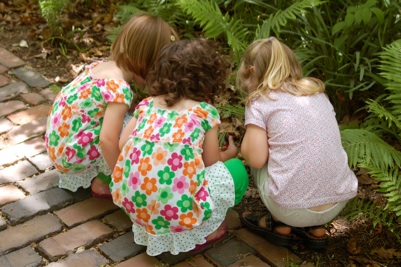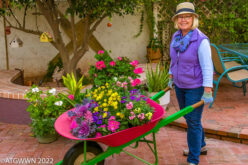The Children Inside Us


The San Diego BG, near Encinitas, CA opened a new children’s garden in the summer of 2009. Visiting this beautiful botanical garden and missing a visit to the children’s garden is a loss to anyone of any age. As busy adults we easily miss the whimsy and wonder of nature. A children’s garden touches the child that still resides in all of us. Happiness sprouts as we wander through such special places filled with topiary animals, rooftop gardens and pint size potting benches.
So as you set out to see the 7 sites on the RGRP tour this month, “Don’t skip the children’s garden!” The “Sensory Garden” at the Montessori school introduces nearly 90 children to nature. Maria Montessori believed there “is no separation between the indoors and outdoors” where learning is concerned. The young child in nature is a joy to see as they explore paths through the garden, touch the petals of flowers, smell the sage, mint and orange blossoms, and watch butterflies, birds and bees.
The lucky children who learn in this garden take observation walks every day. A teacher leads a small group of 4-5 children through the paths as they connect concepts of practical life skills, sensory development, language and mathematics to nature. Perhaps it works something like this:
In the Fall, the bright green leaves of the orange tree provide shade from the sun. Look closer, there are little green balls on the tree! The shape from the classroom is on the tree and the balls grow bigger every week. Shapes and colors learned in the classroom show up all over the tree as the balls grow bigger and change to orange. The thirst for orange juice becomes stronger and upon harvesting these eager learners carry the fruit into their life skills classroom and one orange at a time extract the juice from the orange. Their eye hand coordination is strengthened, their muscles engaged. The juice is poured through a strainer into a pitcher. Their classmates share and the juice is savored. All the senses are involved.
Clean up time and the seeds of the orange remain, how many seeds did the orange have? Here is a chance for counting! Discovery that one orange has more seeds than another generates curiosity and surprise. As the observation walks continue and the seasons change the oranges leave the tree. The Spring brings new balls on the tree, this time the balls are white and as the days pass the white balls change their shape and open into a flower. The flower has petals, how many does each flower have? The scent of the garden is different and the children seek out the source of the scent. The petals begin to fall, the flowers are going away, there is learning of loss and change and still more discovery. For every flower there is a new little tiny ball on the tree. The cycle begins again and the learning continues. All this learning around an orange tree,

A Children’s garden renews my faith in our future as I see how caring, creative adults provide access to nature inviting the next generation into the wonders of our natural world. So on our RGRP tour wander through the Sensory Garden and imagine the children in the garden. Make time to pet Starry, the sheep, say hello to the black face lovebirds and stroll through the connected circular plots of the sensory garden. Let the child in you experience the wonder of nature and when you next visit a public garden, remember, never skip the children’s garden!
Originally published
@http://cals.arizona.edu/maricopa/garden/mgcentral/uploads/RSFeb2010.pdf

